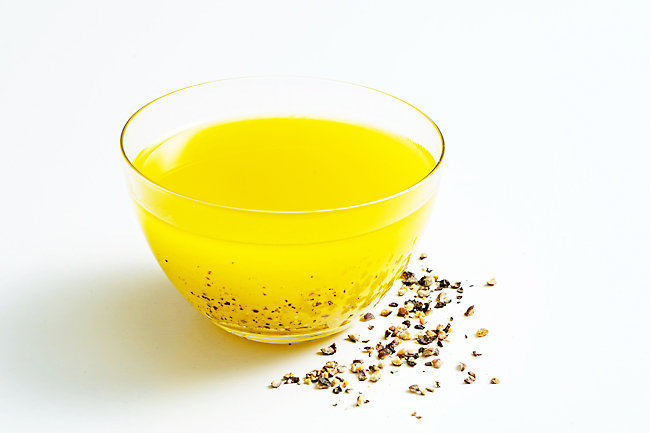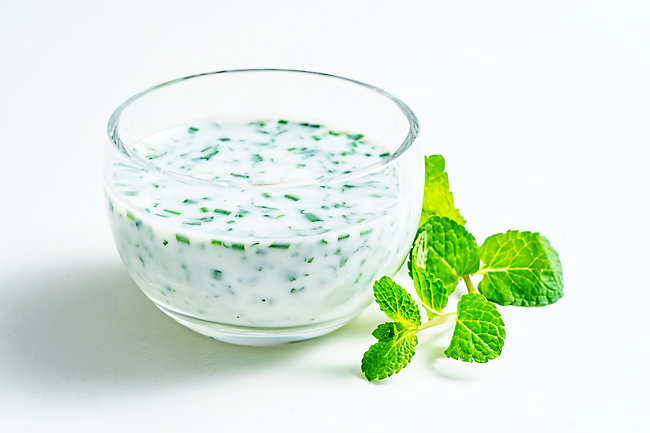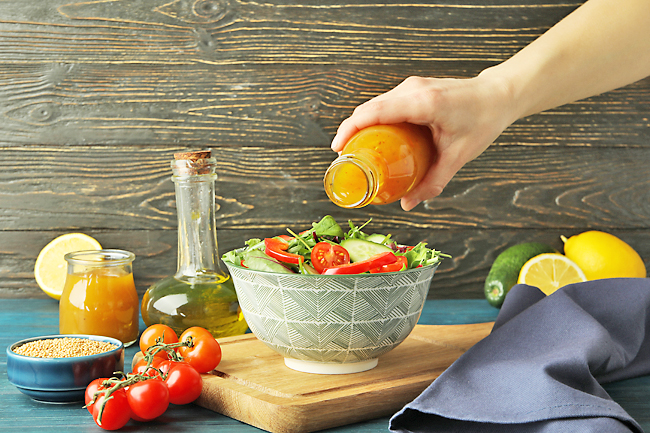G Daniela Galarza
THE WASHINGTON POST – There are perhaps hundreds of thousands of recipes for salad dressings – sauces that can dress greens or other dishes. Almost all of them can be distilled into three essential elements.
“The most important thing about any dressing is to strike a proper balance of salt, fat and acid,” wrote Samin Nosrat in her book on the elements of cooking, Salt, Fat, Acid, Heat.
Individually, those three components are the most basic of seasonings for all food, working to enhance flavour as it hits our tongue and comes into contact with our saliva.
Mixed together in the right proportions, that trio is the base for nearly every type of modern dressing. That said, there is quite a difference in flavour and consistency between, for example, a lemon vinaigrette and blue cheese dressing.
Usually uncooked, a dressing relies on a combination of acid and fat. The acid is anything liquid and acidic, or below a 7.0 on the pH scale.
Vinegar or citrus juice are the most common acids, but tomato juice or soy sauce work, too. The fat is often oil, but doesn’t have to be – creamy dairy and nondairy fats, such as avocado, also play heavily in the dressing space. Salt can be adjusted to taste.



Most dressings fit neatly into one of two categories: vinaigrettes, which tend to be higher in acidity and are pourable, and creamy dressings, which are fattier and often more viscous.
If you think of dressings as formulas, you’ll be free to mix and match ingredients according to your own tastes and dietary needs – and you might just come up with your own favourite house dressing.
Below, I’ve outlined the fat and acid ratios – you can add salt to taste – for vinegar-based dressings and creamy dressings, along with explanations for how to tweak each base recipe to make a variety of other popular or unique dressings.
The final section includes a list of outliers, dressings whose additional ingredients alter the formula of acid to fat, but nevertheless result in wonderful sauces for salads, spreads for sandwiches and dips.
Use this as a guide to learn more about the dressings you know and love, and then tweak them with more or less acid, fat and seasoning until they taste just right.
VINAIGRETTES
One part ACID + three to four parts OIL
Vinaigrettes, or vinegar-based dressings, are almost always made in a ratio of one part acid to three or, for less astringent flavour, four parts oil.
ACID: Traditionally, vinaigrettes are made with vinegar. But any kind of acidic ingredient can fill in, including citrus juice, tomato puree or soy sauce.
OIL: The oil in a vinaigrette can be neutral, such as grapeseed, or nutty, such as walnut. Any oil or fat that is liquid at room temperature can be used in a vinaigrette.
OTHER INGREDIENTS: Many vinaigrettes incorporate emulsifiers – ingredients that help the water-based acid blend with the oil – sweeteners and seasonings. Below, find the base recipe, plus a number of common variations.
BASIC VINAIGRETTE
Makes one cup
Dressing may be stored in the refrigerator for up to two weeks.
INGREDIENTS
Quarter cup white vinegar
Three-quarter cup extra-virgin olive oil
Fine salt
Freshly cracked black pepper
DIRECTIONS
To a small bowl, add the white vinegar. Whisk as you pour the olive oil into the vinegar in a steady stream. Continue whisking until the mixture thickens slightly. (It may separate, and this is fine.) Season to taste with salt and pepper.
VINAIGRETTE VARIATIONS:
Balsamic vinaigrette: Use balsamic vinegar instead of white vinegar.
Red vinaigrette: Use red vinegar instead of white vinegar.
Lemon vinaigrette: Use fresh lemon juice instead of white vinegar, and add the zest of one lemon.
Mustard vinaigrette: Add one or two tablespoons of Dijon or whole grain mustard to the vinegar before whisking in the oil.
Honey vinaigrette: Add one or two tablespoons of honey to the vinegar before whisking in the oil.
Sesame vinaigrette: Use rice vinegar, quarter cup toasted sesame oil and half cup canola oil.
Ginger-miso vinaigrette: Use rice vinegar, and add one tablespoon grated fresh ginger and two tablespoons shiro (white) miso to the vinegar before whisking in the oil.
CREAMY DRESSINGS
One part ACID + eight to 16 parts FAT
Creamy dressings start with acid, but instead of oil, typically use a thicker fat.
ACID: Any kind of acidic ingredient can be used in creamy dressings, including vinegar or citrus juice.
FAT: Mayonnaise, buttermilk, sour cream, yoghurt and mashed avocado can all form the base of a creamy dressing. The ratio of acid to fat is much lower – one part acid to eight to 16 parts fat, often resulting in a thicker dressing that can be used as sandwich spreads or dips.
OTHER INGREDIENTS: All creamy dressings incorporate other flavourings and seasonings, especially herbs, spices and sweeteners. Find the base recipe below, plus a few variations.
Ranch, blue cheese and any dressings that are heavy in fat fall into this category.
HERBY BUTTERMILK SALAD DRESSING
Makes about one cup
Refrigerate for up to three days.
INGREDIENTS
Three-quarter cup buttermilk, plus more as needed
One tablespoon fresh lemon juice or white vinegar, plus more as needed
Three tablespoons finely chopped fresh herbs, such as parsley, chives and/or mint
One teaspoon granulated sugar (optional)
Fine salt
Freshly cracked black pepper
DIRECTIONS
In a small bowl, whisk together the buttermilk, lemon juice or vinegar, chopped herbs and sugar, if using, until combined. Taste and add more buttermilk or lemon juice, if desired.
Season to taste salt and pepper. Use right away or refrigerate until needed.
CREAMY DRESSING VARIATIONS:
Ranch: Add a quarter teaspoon of each garlic powder and onion powder.
Blue cheese: Use one-third cup buttermilk or yoghurt, one-third cup sour cream and one-third cup mayonnaise, and add one third cup (three ounces) crumbled blue cheese.
Avocado-herb: Use all mashed avocado, or half avocado and half yoghurt. Thin the dressing with water or citrus juice as needed. Can be made in a food processor.
OTHER DRESSINGS
Outliers in the dressing category take liberties with these two tried-and-true formulas.
Some alter the ratio of acid by adding pureed fruits or jams or vegetables. Others use fat in the form of pureed nuts or seeds. The end results are marvellous though, so don’t forget that there are lots of ways to expand beyond the two basic formulas.
This category includes famous dressings such as Russian and Thousand Island, close cousins that incorporate ketchup, an acidic emulsion that contains lots of sugar to balance its final flavour.






